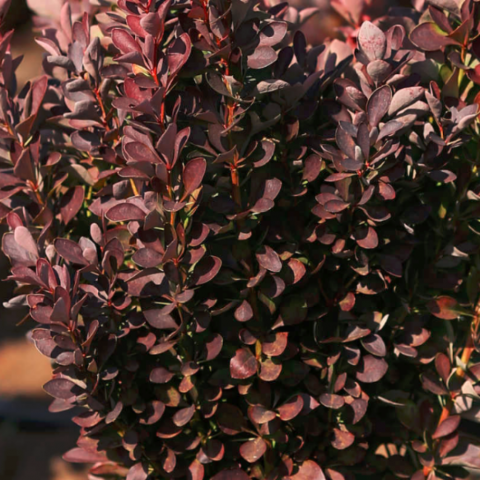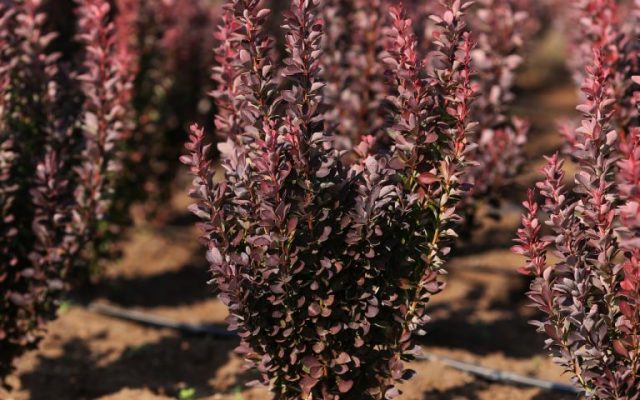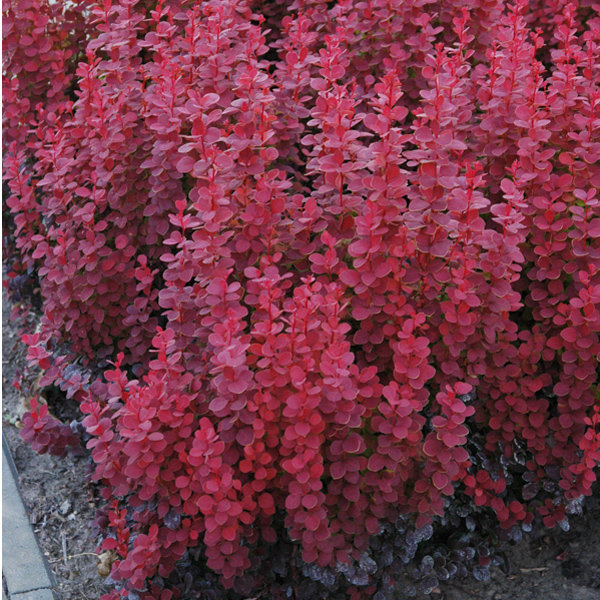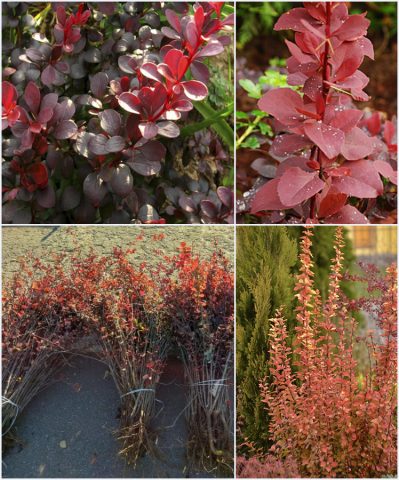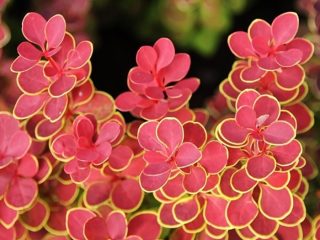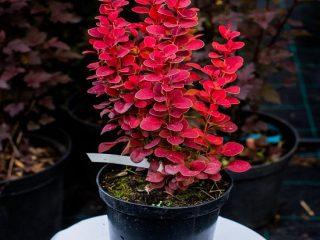Content
Among Russian gardeners, shrubs of the Barberry family are gaining more and more popularity for their unpretentiousness to the surrounding conditions and a valuable decorative look. Barberry Thunberg Red Rocket is of particular interest even among novice gardeners for its unusual color and narrow strict shape.
Description of barberry Red Rocket
The thorny deciduous shrub of the Thunberg Red Rocket variety can be seen in any Russian region. This is facilitated by its resistance to different climatic conditions. The description of the Red Rocket barberry allows you to find out what an adult shrub will look like 7-8 years after planting, and the image in the photo will not allow it to be confused with other varieties:
- an adult bush is tall and reaches a height of about 2 m;
- the crown is not spreading, erect, its width ranges from 0.6 to 1 m;
- branches are long and thin, densely foliated, growing vertically upward, giving the entire plant a columnar shape;
- leaves are rounded, slightly elongated, in summer they have a rich dark red color, in autumn they brighten a little and look light red;
- flowers are small, bright yellow, collected in small brushes, bloom in May, with abundant flowering, they emit a sweetish aroma that attracts bees;
- berries ripen at the end of September, have an oblong shape and bright red color, due to the high content of alkaloids, they have a bitter taste, therefore they are not eaten;
- spines are numerous, elastic, up to 1 cm long;
- annual growth averages about 15 cm.
Shrub barberry Red Rocket grows well in a sunlit area. In partial shade, it can also be planted, but with a strong lack of sun, the leaves turn green and lose their decorative appeal.
The bush feels confident on slopes and hills, where there is no stagnation of groundwater. Thanks to the developed root system, this variety of barberry is planted to strengthen the slopes and banks.
Barberry Red Rocket in landscape design
The main application of barberry Red Rocket found in landscape design. Purple bushes in combination with other varieties of yellow and light green barberries, as well as the contrast of their yellow flowers against the background of red foliage, allow you to create a picturesque composition that attracts all the attention.
Good adaptation in urban conditions and the columnar shape of the bushes make it possible to create a hedge of dark red barberry, both in a free-growing style and in a shorn form.
Landscape designers plant Red Rocket barberry bushes when creating alpine slides, decorating mixborders. Single plantings in pots can be repositioned as desired. The photo clearly shows that the Tunberg barberry Red Rocket is an element of the garden composition, which allows designers to express their imagination to the maximum.
Planting and caring for barberry Red Rocket
The main conditions for lush and prosperous growth are the location (it should be sunny) and the composition of the soil - preferably without stagnant water with neutral acidity. Otherwise, caring for barberry includes all the procedures necessary for shrubs:
- watering;
- top dressing;
- pruning;
- loosening;
- prevention against pests;
- preparation for winter.
Seedling and planting preparation
When buying Red Rocket barberry seedlings in a specialized store, special attention should be paid to the condition of the roots and leaves - they must be healthy. Before planting in the ground, it is recommended to lower the roots for several hours in a bucket of water.
Seedlings bought in a container are carefully removed with the soil and lightly watered with water so that the soil and roots are moist when planting.
The selected area is dug up before planting to enrich the land with oxygen and remove weeds... If the acidity is very high, then it is necessary to add a solution of lime or wood ash during digging.
Landing rules
For a single planting, it is recommended to place the bushes at a distance of about 1.5 m from each other. Planting a dense hedge will require 4 barberries per 1 running meter. m.In the free-growing version of the bushes, when planting a hedge, there should be at least 0.5 m between the seedlings.
Landing is carried out according to the following algorithm:
- Dig a hole corresponding to the root system of the seedling (most likely, it will be 0.5x0.5x0.5 m in size).
- Lay drainage 15 to 20 cm high.
- Fill in half with a fertile mixture consisting of: land from the site, humus, sand in approximately the same proportions.
- Place the seedling in the center.
- Fill up the earth to the level of the plot, tamp it slightly.
- Drizzle with water.
Mulching with tree bark, dry foliage, and a small decorative stone in the trunk circle will allow the earth to keep moisture longer and not dry out in hot weather. To plant a hedge, they dig a trench where all the seedlings are placed.
Watering and feeding
The irrigation regime of the Red Rocket barberry depends on the climatic conditions of the place where it grows. This type of shrub is drought-resistant and does not like waterlogging. If the summer is rainy, then the barberry does not need to be watered, there will be enough natural moisture. In dry weather, do 1 watering per week. A bucket of water is poured onto the bush.
If the Thunberg Red Rocket barberry is planted according to the rules in a fertile mixture, then the first feeding is carried out for 2 years and further, nitrogen fertilizers are applied once every 3-4 years. Complex fertilizers are applied before each flowering.
Pruning
Young bushes, planted for free growth, carry out 2 types of pruning: rejuvenating and sanitary.
Sanitary pruning is done every spring after the snow melts, before the leaves begin to open. Remove frozen, dry and diseased shoots.
A rejuvenating haircut is needed when the Red Rocket barberry is 7-8 years old. It is carried out in the fall, removing old branches growing near the ground, and removing part of the young stems in the crown.
There is one more type of trimming - molding. It is used when growing a hedge or to give a bush a certain shape. Such pruning is done, a couple of years after planting the seedling, when the barberry has faded.
Preparing for winter
The unpretentious care of the Thunberg Red Rocket barberry variety also includes its winter hardiness. The territory of Russia has different climatic conditions. This must be taken into account when growing barberries. If the winters are not very frosty and snowy, then there is no need to cover the bushes, only very young ones - 2-3 years old.
When a severe frost is expected, and little snow has fallen, then to preserve the plant, it is better to cover it for the winter with spruce branches, peat or straw.
Reproduction
There are different ways of breeding Red Rocket barberry. Not all of them can be successfully used in the garden. But a novice gardener should know about them. You can propagate this variety:
- cuttings;
- layering;
- dividing the bush;
- seeds.
Layers and cuttings are most often used, since with this method of propagation, the varietal qualities of barberry are preserved. Cuttings can be carried out at any time of the year, except for winter. Summer cuttings are considered the best for gardeners. They are green and take root faster.
The method of dividing the bush is applied to young plantings, which are easy to dig up without greatly damaging the roots. But the probability of survival of a young shrub is not always 100%.
Seed propagation is also possible with proper seed preparation. Seeds can be planted in autumn or spring after 3 months of stratification. This method requires a long time (about 2 years), has poor germination and does not retain the qualities well enough due to which this Red Rocket variety is grown.
Diseases and pests
The resistance against fungal diseases and pests in the Red Rocket barberry is high. However, you should be aware that there are diseases that develop only on the bushes of the Barberry family. Also, in the case of a weakened immune system, even these resistant varieties can get sick with some types of fungal diseases.
Powdery mildew, leaf spot, wilting and drying of shoots, bacteriosis are caused by various pathogenic fungi, against which it is necessary to carry out preventive spraying with special copper and sulfur-containing fungicides before flowering. If the disease has just appeared, then you should immediately fight it. Otherwise, premature leaf fall will begin.
The insect, the barberry aphid, causes the leaves to dry out and wrinkle. Against her, the bush can be sprayed with a solution of laundry soap or tobacco. The flower moth, which eats the fruits, is considered dangerous. To combat the caterpillar, the bush is treated with chlorophos or appropriate insecticides.
Conclusion
The Thunberg Red Rocket barberry represents a successful breeder's work. Having many advantages, this variety is practically devoid of disadvantages and gratefully responds to taking care of it. You can grow this barberry in order to admire the unusual color of the foliage in almost any Russian region.
